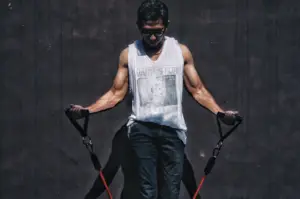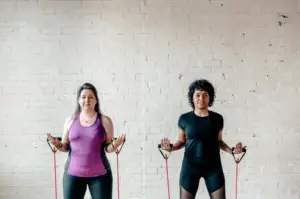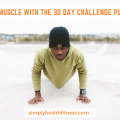Big arms are fun – but building muscle mass in your arms can be a slow challenge – while many of the most popular upper body exercises use weights.
Resistance band exercises are one of the ways you can make sure you’re getting results in the arms with consistent, effective training. Today we’re discussing the best resistance band workouts for arms and how you can bring arm training home with nothing more than a set of resistance bands.
Why Use Resistance Bands?
Resistance training – from bands or weights – is one of the best forms of exercise. It’s at the root of muscle gains, strength, healthy joints, and better bone density – not only building strength. It’s both amazing for changing how you look and perform but also your health and wellbeing in the long-term.
You can take a resistance band set with you anywhere, too, making them a versatile type of fitness equipment.
The resistance band exercises we’re talking about today also include some bodyweight training. You don’t need weights for any of these exercises, only your bodyweight and a band – but ideally a few.
Sets of bands are the best because they offer more training options and the chance to get the right band tension for you. You can get high-quality resistance band sets with a range of resistances from 5lbs to 170lbs in high-quality sets that let you build bigger arms at home.
Top 6 recommended resistance band exercises that will get you results
1. Bicep Curl
Resistance band bicep curls train the biceps directly, isolating the muscle and improving strength and size.
You can bicep curl in many different ways. You can stand on the resistance band or anchor it under a heavy object for curls. Ideally, the angle of force should be down and forwards so that you get tension as you curl up and towards yourself. This helps focus on the squeeze at the top of the movement and improves bicep strength.
The goal of the curl is to feel the band tension and focus on keeping the elbow in one place while it closes and opens. Keep your chest proud, elbows just ahead of your body, and move slowly through the exercise. Reps should typically be quite high, ideally working in the 8-15 range, depending on band tension. With slower reps and good pauses, you can make this a very challenging and effective exercise.
How to bicep curl with a resistance band
- Set up with your feet shoulder width apart to create tension, standing on the band and hands evenly spaced on the band with palms facing up
- Keep your hands inside of shoulder width with a firm grip on the band itself
- Bend over slightly – with the knees slightly bent – keeping a proud chest throughout
- Keeping the elbows in a single, fixed position, bend the arms and close the elbow joint
- Hold the movement for a few moments at the top, squeezing your biceps to resist the band tension
- Slowly reverse this movement, allowing your arms to straighten and flexing your tricep briefly in the bottom position, completing the rep
Bicep Curl Resistance Band – YouTube
2. Tricep Extensions
The tricep extension is the opposite of a curl – it isolates the elbow joint in extension rather than flexion. You’re pushing, instead of pulling, and the focus is on pressing the band down, flexing the triceps, and locking out the arms.
There are 3 different types of tricep extension that are best to use with a band: the classic tricep extension, the pushdown, and the kickback. These all focus on keeping the chest proud, the shoulders tucked down (away from your ears), and extending the range of motion.
Standing or seated tricep extensions are great for stable, elbow-healthy tricep gains. They’re a way of improving your full-range tricep strength and flexibility. They are anchored low, and can be performed with either one or two arms, which lets you scale the band tension to your strength levels.
Tricep Extensions Resistance Band – YouTube
Tricep Pushdowns are a downward motion from a high-angled anchor.
These are great for long ranges of motion and really getting the shoulder-involvement of the tricep. This trains the long head more effectively, combining the push down and towards yourself for a great ‘squeeze’.
Tricep Kickbacks are a great ‘finisher’ exercise and really focus on the squeeze at the end. They don’t develop the long head of the tricep as well, so they’re best at the end of a workout for a great pump and additional loading to build bigger arms.
You can also perform Banded Skullcrushers with a band if you’ve got an appropriate surface to lay on, offering a great long-range, deep squeeze exercise. It’s a great way to really focus on the end of the extension and proper elbow lockout.
Lying Skull Crushers – YouTube
How to perform a standing band tricep extension
- Stand on top of the band with feet hip width apart, allowing enough slack to grab the upper portion of the band behind your shoulders/head – with your palms facing the ceiling
- With a firm grip on the band and your core engaged, set your shoulders down and keep your elbows in one position throughout
- Extend the arms, pressing the band away from yourself and keeping your shoulder blades tucked down
- Squeeze the tricep at the top of the movement, pausing briefly, trying to “find” the muscle
- Slowly reverse the movement under control until you reach the starting position, flexing the bicep briefly, and completing the exercise
3. Band Bent Over Row
You can use a band to ‘row’, combining benefits to the upper back and arms at the same time. This comes with some variation, too, letting you get versatile with your banded arm workouts.
You can anchor a row against a heavy object or beam to perform a more horizontal pull. This offers both 1- and 2-arm variations that let you perform the exercise with adjustable band tension.
You can stand on a band with feet shoulder width apart and perform a bent-over row, or you can loop the band around an upright pole or similar to take the stress off your back. These both offer excellent bicep activation to help your arms grow – but take some of the stress off of shoulder retraction – so make sure to mix it up and use both in your resistance band workouts.
These are both great exercises that help you build the arm muscles and upper back together. It’s a great place to start for any resistance band arm workout.
How to row with a resistance band
- Stand with your feet hip width apart with knees slightly bent, pull the band taut, and maintain tension on the band
- Take the starting position with the band in your hands at shoulder width and arms straight (relaxed)
- Keep your chest proud and bend over, pushing the hips back until your armpits are just above the band
- Pull the band towards yourself, bringing your hands towards your hips and pulling the elbows back to engage the back muscles
- Squeeze the shoulder blades together and close the elbow joint, squeezing the biceps, to keep the band close to the body.
- Slowly lower the band to the starting position to complete one repetition
Note: you can use either palms facing up (supinated) or palms facing down (pronated) grip for this exercise.
4. Banded Push-Up
Adding a band to push-up is a great way to get more load on your triceps – as well as the chest and shoulders. This is a full upper body pushing exercise that builds the arms through sheer load and challenge.
For most people, the banded push-up is a more challenging exercise that is great for the start of a resistance band arm workout. With enough band tension, it works like a bench press and you can usually get great results with 8-15 rep sets.
This is a ‘heavier’ workout compared to isolation exercises, giving you a chance to build strength and muscle mass with a resistance band in your own home. This also helps you progress your bodyweight strength training like dips.
You can progress banded push-ups with both band tension and reps. Use a rep goal that is challenging for your chosen band – focus on getting to that number of reps in as few sets as possible. Then move on to smaller, isolation exercises once you’ve pre-fatigued the arm muscles.
How to perform a banded push-up
- Take a band in either hand at shoulder height so that that it crosses your upper back
- Press your arms straight, adding tension to the band as you assume the starting position
- With your core tight and a perfect straight line from feet to head, set up in a straight arm plank position and lower yourself to the floor by bending the elbows
- Pause briefly in the bottom position, keeping your core muscles engaged, before pressing the world down and squeezing the triceps to make your arms fully extended. Feel the tension in the upper arms and hold the position briefly – resisting the band tension
- Slowly lower yourself back to the floor, keeping the upper back muscles active throughout to keep your chest big and prevent back rounding
- As you return to the bottom position, the exercise is completed
Join our 30 days push up challenge here
5. Banded chin-up
This is an easier version of the pull-up that you can use a band for. The band takes some of your weight off at the bottom of the movement and allows you to perform more reps. Alternatively, it just makes chin-ups and pull-ups possible for many people who can’t perform them with their entire body weight.
Obviously, you need a high bar for performing chin-ups.
This can be a limiting factor for many workouts. This is a heavier exercise that builds strength and is more challenging. It works perfectly with rep goals, since you can’t change your bodyweight and each rep is actually quite difficult.
The banded chin-up should go at the start of your resistance band arm workout, pre-fatiguing the upper body and building the muscles of the upper back. Then you can add your isolation exercises on top and gain serious muscle mass in the arms.
How to perform a banded chin-up
- Set up a resistance band looped around the pull-up bar to produce a loop big enough to place your knees in
- Take your starting position by gripping the bar roughly shoulder width apart with straight arms, pulling the band down, and feeding your knees into the looped band
- Begin the exercise by pulling your chest up towards the bar, bringing the elbows down and back while squeezing the scapulae together
- Continue pulling up until you reach the top of the movement, where you should squeeze with the biceps and shoulder muscles as long as possible
- Slowly lower yourself down, feeling the stretch through the biceps and back as you reach the starting position and complete the rep
6. Banded dips
Dips are a powerful upper body workout. They’re great for building arm muscles since they load the triceps heavily. The narrower-grip ‘tricep dip’ is perfect for building huge arms and actually builds plenty of strength, too.
Banded dips are a way of either reducing or increasing the load. You can use band-assisted dips to make the movement easier as a beginner and scale up, building strength at your own pace. On the other hand, you can use band-resisted dips to add more load and build enormous triceps with just bands and bodyweight.
This is a heavier exercise than banded push-ups, and offers a place to progress when you need serious gains. It’s a lower-rep exercise, typically, for beginners. Dips may be sets of 5-12. If you can do more than 12, you should add band tension or remove band assistance.
How to perform a banded dip
- With a resistance band looped around the dip bars, take a comfortable grip between chest height and shoulder height with a firm grip
- Take a kneeling position with the band around your knees and your torso stable and arms extended
- Hinge forward slightly, keeping your core engaged and upper arms aligned with the dip bars, without letting your chest hinge too far forwards through the entire movement
- Lower yourself, keeping the upper back engaged and bend elbows as far as is either possible or comfortable, maintaining tension on the triceps
- Slowly return to the starting position by extending the arms, focusing on the upper arm and pushing your chest up and forwards – until you get back to the same position you started from – completing a rep
Resistance Band Arm Workout FAQ
Can resistance bands build muscle?
You can definitely build muscle with resistance bands. The elastic tension is a great way to keep the muscle loaded through a whole movement. It’s typically lighter than weight training, so you may want to get sets of bands that allow you to get more band tension for some exercises.
This added versatility also means you can progress more effectively – the key to building more muscle mass.
Are resistance band workouts effective for the upper body?
Resistance band workouts are effective for building muscle and strength, improving joint health, and even addressing posture. The constant tension is great for muscles and joints alike, making bands a great training tool for beginners and elite athletes alike.
Bands build muscle but are also great for flexibility. They are perfect for forcing you to control the movement, especially in movements like band pull-aparts and shoulder dislocates. Bands are a popular choice in rehabilitation and recovery, where they are used for tendon strengthening and low-impact upper body exercises.
Will resistance bands make my arms bigger?
You can make your arms bigger with resistance band workouts. They’re a great way to build muscle and strength at home. Band tension is great for providing the mechanical tension that muscles need to grow and get stronger.
Having a range of different bands is a great way to overload your muscles. It does also require smart dieting and sleep, however – bands are just one part of the picture.
Band resistance and progression through different exercises to add more load are key. Start with lighter bands and simpler exercises then progress either the resistance, the complexity, or the reps/sets to build more muscle.
Conclusion
Resistance band workouts are a great way to bring fitness home and build bigger arms. They’re a great tool for building strength and muscle in the biceps and triceps, as well as helping keep your elbows and shoulders healthy.
Combining heavier and lighter band exercises helps you to get a full workout that covers strength and muscle alike. Use these exercises and you’re well on your way to bigger arms, a stronger upper body, and joints that are ready to keep progressing with you.







